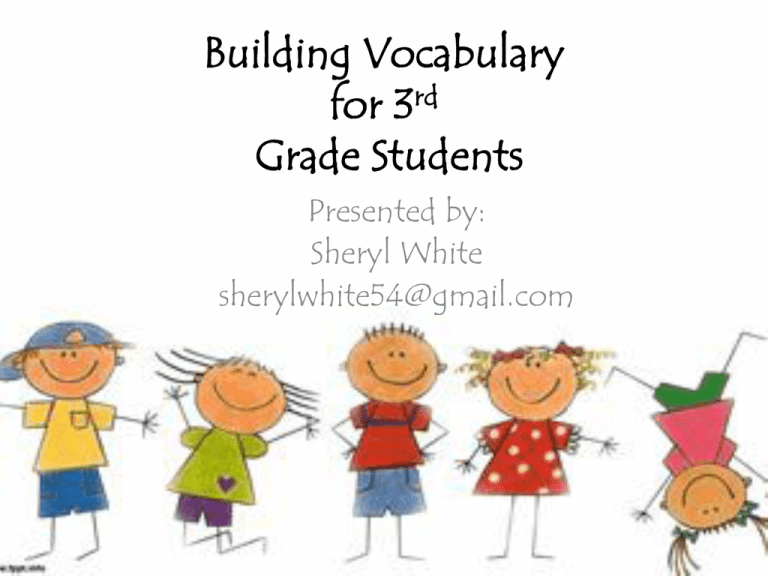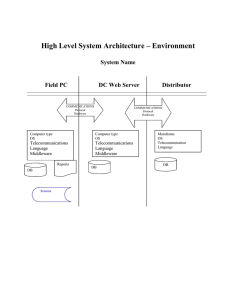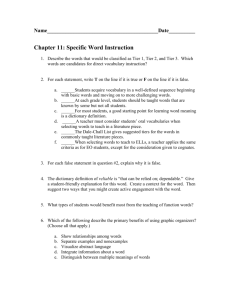Building Vocabulary Through Text
advertisement

Building Vocabulary for 3rd Grade Students Presented by: Sheryl White sherylwhite54@gmail.com Session Objectives • Understand vocabulary demands in the Common Core State Standards • Understand the Tiers of vocabulary • Understand the importance of direct vocabulary instruction to improve comprehension of text, speaking, listening and writing • Gain instructional strategies that will enhance vocabulary instruction How much do you know about the 3 tiers of vocabulary? Use a 1 Not heard of three tiers of vocabulary to show your current understanding. 2 Very little knowledge of three tiers of vocabulary 3 Some familiarity of three tiers of vocabulary 4 Know three tiers of vocabulary and how to use 5 Deep knowledge of three tiers … can teach others Common Core Vocabulary 3rd Grade L.3.5 Demonstrate understanding of word relationships and nuances in word meanings. • L.3.5.a Distinguish the literal and nonliteral meanings of words and phrases in context (e.g., take steps). • L.3.5.b Identify real-life connections between words and their use (e.g., describe people who are friendly or helpful). • L.3.5.c Distinguish shades of meaning among related words that describe states of mind or degrees of certainty (e.g., knew, believed, suspected, heard, wondered). Common Core Vocabulary 3rd Grade L.3.6 Acquire and use accurately grade appropriate conversational, general academic, and domain specific words and phrases, including those that signal spatial and temporal relationships (e.g., After dinner that night we went looking for them). What do we need to do? Vocabulary instruction is a priority in the Common Core. Teachers need to: • Explicitly teach vocabulary in all subject areas. • Engage students in learning new words. How do we get our students excited about learning new words? Vocabulary… Why Teach It? • Talk to an elbow partner about the question. • Share your ideas with the others at your table. • Record as many reasons as you can for teaching vocabulary. Let’s at some of the research related to vocabulary development. Reading comprehension = Knowledge of Words + Knowledge of the World What Does Research Say? Homes rich in communicationChildren before the age of four have heard 45 million words. Homes that lack rich communicationChildren before the age of four have heard 13 million words. (Hart and Risley 1996) Actual Differences in Quantity of Words Heard In a typical hour at home, the average child would hear: Welfare Working class Professional 616 words 1251 words 2153 words Meaningful Differences in the Everyday Experience of Young American Children, Hart & Risley Sadly, socioeconomic status has the most significant factor effect on a child’s vocabulary knowledge. More Research Findings… Third grade students with restricted vocabulary have declining comprehension scores. The gap continues to widen during the elementary years. By the end of second grade, students in the highest vocabulary quartile know 4000 more root words than students in the lowest vocabulary quartile. Effective Approaches to Teaching Vocabulary • Exposure to High-Quality Oral Language • Reading Aloud to Students-Word Consciousness • Explicit Vocabulary Instruction • Word-Learning Strategies • Wide Independent Reading Less Effective Approaches to Teaching Vocabulary • Copying definitions from a dictionary • Writing sentences with vocabulary words before studying the words • Using context to figure out the word • Memorizing a list of “decontextualized” words High-Quality Oral Language • Use high quality vocabulary in the classroom. • Tell students the meaning of words when first used. – “Don’t procrastinate on your work. Procrastinate means to wait to do something you should be doing already.” – Pair in the meaning of the word by using parallel language. “Please refrain from talking. Please don’t talk.” COLLEGE TALK High-Quality Oral Language I really have to try hard while climbing this big mountain! I really have to be persistent while climbing this enormous mountain! Reading Aloud Vocabulary can be gained from listening to others read. – Listening to a book being read can significantly improve children’s expressive vocabulary. – Print vocabulary is more extensive and diverse than oral vocabulary. – Wide disparities exist in the amount of time parents read to their children before lst grade. Reading Aloud Vocabulary can be gained from listening to others read. – Choose interesting, engaging stories that attract and hold children’s attention. The books should also be somewhat challenging. – Use performance-oriented reading. Read with expression and enthusiasm. – Provide students with a little explanation of novel words that are encountered in context. Explicit Vocabulary Instruction • Vocabulary activities specifically designed to teach new words • Explicit vocabulary strategies – Use informational and narrative texts as tools – Promote thinking and extend discourse – Encourage use of novel words – Provide extended access to print – Examine word relationships – Teach word parts – Use graphic organizers 20 Successful Vocabulary Instruction A successful approach to vocabulary instruction involves directly explaining the meanings of words along with thoughtprovoking, playful and interactive follow-up. Common Core and Three Tiers of Vocabulary Three Tiers of Words Tier One Tier Two Tier Three High Frequency Words Academic Vocabulary Domain-specific Vocabulary 24 Three Tiers of Vocabulary Tier 1- Everyday Words (implicit) –Used in everyday speech* –Words English Language Learners will need to learn chair, bed, happy, house Three Tiers of Vocabulary Tier Two = Academic Vocabulary • Words in general use, not content specific • Appear far more in written texts than in speech – concentrate, absurd, fortunate, relieved, dignity, convenient, observation, persistence ++describe, detail, example Three Tiers of Vocabulary Tier Three- Domain-Specific Words • Words related to a specific content or field of study – triangle, stem, addition, syllable – tundra, igneous, triangle, perpendicular, democracy Three Tiers of Vocabulary Tier 1 Tier 2 Tier 3 Description Basic words that most children know before entering school Examples clock, baby, happy Words that appear frequently in texts and for which students already have conceptual understanding coincidence, fortunate, insist, adapt Uncommon words that are typically associated with a specific domain or content area chrysalis, peninsula, decimal (Beck, McKeown, Kucan, 2002) Explicit Vocabulary Instruction Sources of Words Sources of words for vocabulary instruction – WORDS from read-aloud books – WORDS from core reading programs – WORDS from reading intervention programs – WORDS from content area instruction and texts • Math • Science • Social studies • Health • Art, PE, music, etc. Explicit Vocabulary Instruction Selection of Words Select words that : • are likely unfamiliar • are critical to passage understanding. • students are likely to encounter in the future and are generally useful. • are Tier Two words (Academic Vocabulary) • are easily explained to children at their level (Beck & McKeown, 2003) (Stahl, 1986) Explicit Vocabulary Instruction Selection of Vocabulary • “Goldilocks Words” – Not too difficult – Not too easy – Just right (Stahl & Stahl, 2004) Three Tiers of Words Sorting Activity Place the list of words under the appropriate Tier by referring to the descriptions above. Tier One Words Tier Two Words Tier Three Words How did you do? Choosing Tier Two Words Her thoughts were interrupted by loud shouts and a commotion from the wedding party assembled outside. Manyara was missing! Everyone bustled about, searching and calling for her. When they found her footprints on the path that led to the city, they decided to go on as planned. (Mufaro’s Beautiful Daughters, John Steptoe) Your Turn Selecting Tier 2 Words • At your table, choose one of the texts you have brought to work with today. • Identify (4 )Tier 2 words you would teach your students. • Use the selection criteria page to help guide you through this process. How do I determine that a word is TIER Word Is this a generally useful word? Does the word relate to other words and ideas that students know or have been learning? Is the word useful in helping students understand text? 2? If you answer yes to all three questions, it is a tier 2 word. If not, it is probably a tier 3 word. What Strategies Would You Use to Teach Your Selected Words? Fold the Line The Importance of Providing Student-Friendly Definitions Providing student-friendly definitions—ones that are accurate and that students will understand—is no mean task. Below is a definition of dazzling from the dictionary and a student-friendly definition. Beck, McKeown, and Kucan (2003). “bright enough to deprive someone of sight temporarily” “If something is dazzling, that means that it’s so bright that you can hardly look at it.” Explicit Instruction Student-Friendly Explanations Dictionary Definition Student-Friendly Explanations disgusting - to cause to feel disgust; be sickening, repulsive, or very distasteful to fragile - easily broken, damaged, or destroyed gratitude - a feeling of thankful appreciation for favors or benefits received loitering - to linger in an aimless way; spend time idly 39 Providing Student-Friendly Definitions TASK: • Partner into A and B • Each partner should choose one word each from your earlier selection. • Then take turns providing a student-friendly definition for your word. THIS TAKES PRACTICE and TIME Looking Deeper at Tier Two Words Using the Tier 2 Word List…. • Read the list of words. • Underline or highlight any words you may need to teach your students this year. This is only a sample list of Tier Two words your students may need to learn. There are many others you can select. Spatial and Temporal Relationships Spatial words and phrases • Where = Location Temporal words and phrases • When = Time Spatial and Temporal Relationships • • • • Anchor Charts Sentence Builders Mentor Text Writer’s Notebook A Vocabulary Instructional Sequence for Read Aloud 1. 2. 3. 4. 5. 6. Contextualize the word Say the word together Give a student-friendly definition Use in other contexts Engage students in interactions with words Say the word together. Example: 1. Introduce the word. This word is survive. What word? 2. Present a student-friendly explanation. When people or animals don’t die when things are very bad or dangerous, they survive. 3. Illustrate the word with examples. Look at the people on this river. It is very dangerous. However, they don’t get hurt or die, they __________. Example: 4. Check students’ understanding. (Examples and non-examples) Get ready to tell me if this group would survive. If the winter was very cold and all food was buried under the snow, would whooping cranes survive?________ Ones, tell your partner why they wouldn’t survive? If whooping cranes had plenty of food and the weather was warm, would they survive? __________ Twos, tell your partner why they would survive? (Deep Processing Questions) If a rabbit was being chased by a coyote, what could the rabbit do to survive? Making Vocabulary Active TPR- Total Physical Response • recognizes the value of language being associated with physical responses • grammar-based view of language that focuses on meaning, not form • evidence-based strategy for English Language Learners strong Literal and Nonliteral Meanings Artwork • Have students select a figurative speech phrase such as, “That person is ‘as smart as a whip’” and create a drawing that illustrates it. Label the phrase that accompanies it. • Provide a meaning of the nonliteral words Idiom: Meaning: Real-life Connections Between Words and Their Use Words are all around us. This standard encourages teachers to help students use language to describe his or her world. Real-Life connections between words and their use.. Describe using… • words • phrases • sentences • and pictures. Structured Semantic Mapping (Heimlich & Pittelman) Webbing the Descriptions Your Turn • Each table will be given a “topic” to describle. • Use words, phrases, our sentences to describe your category. • Tell why! • You may draw a picture to add to it. Writing • Have students use their descriptions to compose a piece of writing. • The teacher may guide the student to narrow down their writing to one idea that was generated and described. • For example; “Write about one situation that could be very dangerous. Provide details and descriptions to illustrate why it would be dangerous.” Shades of Meaning Shades of meaning describe words that have slightly different meanings. THE BIG IDEA • Shades of Meaning is a phrase used to describe the small, subtle differences in meaning between similar words or phrases. • For example, ‘mad’ and ‘angry’. Both refer to a feeling or showing of anger, but one seems to be more so than the other. Which one would you say is…? Would you say that these people are all ‘walking’? Semantic Gradients 1. Select a pair of polar opposite words. 2. Generate at least five synonyms for each of the opposite words. 3. Arrange the words in a way that forms a continuum from one opposite word to the other. Continuums can be done horizontal or vertical, in a ladder-like fashion. 4. Have students discuss their rationale for placing certain words in certain locations. Encourage a conversation about the subtle differences among the words. A Staircase of Words _____________________ _____________________ _____________________ _____________________ _____________________ Shades of Meaning • Select a specific vocabulary word, e.g., large. • Create a list of semantically similar words. It may work best to think of your target word as being in the center of your continuum. • Arrange the words in a way that illustrates an understanding of each word's meaning. Continuums can be done horizontal or vertical, in a ladder like fashion. • Have students discuss their rationale for placing certain words in certain locations. • Encourage a conversation about the subtle differences among the words. A Ladder of Shades of Words humongous gigantic huge massive large big A Ladder of Shades of Words Teeter-Totter Words large Shades of Word Meaning Using a sentence strip, record each of these words on a card. Place the card in order from least intense to most intense. stroll, wander, trudge, swagger, stride, tread, shuffle, creep “stroll” – to describe walking for pleasure without hurrying “wander” – to describe walking without specific purpose “trudge” – to describe walking slowly with effort, usually in a tiring and long journey “swagger” – to describe walking as if you are very important “stride” – to describe walking fast, taking big steps “tread” – to describe taking a step on or over something “shuffle” – to describe walking slowly, without taking your feet off the ground “creep” – to describe walking without making any noise because you do not want people to notice you. A Bridge One Meaning to Others • Sort words by degrees or shades of meaning using visual cues • Act out (when possible) the different meanings Awake Tired Drowsy Asleep Shades of Meaning Place the words in order from weakest to strongest meaning. 2 1 4 3 toss, pitch, throw, hurt Using Color • Using paint sample strips to help students see the “shades” of meanings of words • Write in order the words from the cards you have been given. • Try it!!! Shades of Meaning Match Up angry shout delighted yell call cross thrilled happy furious Shades of Meaning Place related words on each line, from mild to medium to strong. mild medium strong Words and Shades of Meaning • Acting out • Play charades-provide students the word choices up front • Simon Says – walk, march, strut, prance – speak, whisper, murmur 3-2-1 List 3 Things You Learned: List 2 Things You Will Try: List 1 Question You Have:




